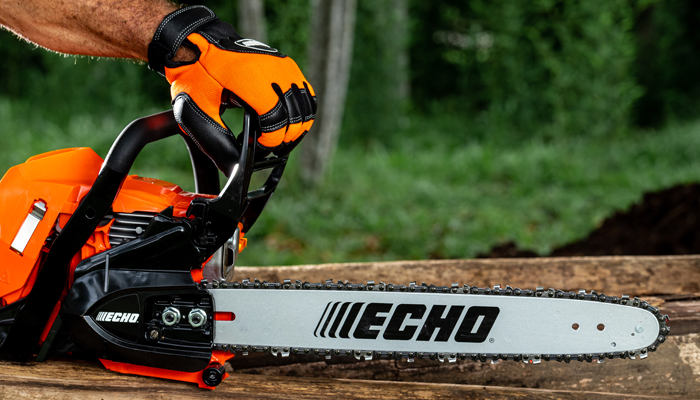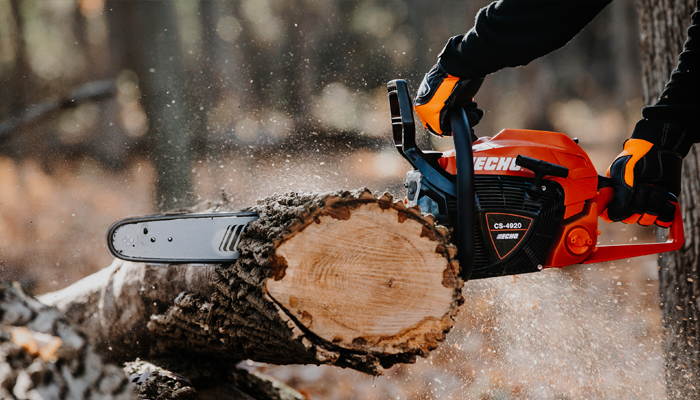Chainsaw Safety Tips
Chainsaws offer a highly efficient way to manage and maintain any property. From trimming and felling trees to cutting firewood, a saw can be one of your most effective tools. However, operating powerful tools like this requires understanding and following some essential safety measures to protect you – and those around you – from potential injury.
Chainsaw safety is more than just being careful; it’s a critical aspect of being a responsible saw owner. Following basic safety guidelines prevents accidents, reduces downtime, and allows you to complete jobs more quickly. The following chainsaw safety tips will ensure you get the most out of your ECHO saw.

Common Chainsaw Hazards
While chainsaws are incredibly robust tools, it's essential to manage them properly to ensure safe and efficient operation. Fortunately, being aware of these considerations can help you use your chainsaw safely and effectively.
Common dangers include:
- Kickback: Kickback can happen when the tip of the guide bar contacts an object or if the wood you’re cutting closes in and pinches the chain. This causes a sudden, forceful back-and-up motion that can easily cause you to lose control of the saw.
- Chain breakage: Chainsaws work under high tension. A broken chain can quickly whip around at high speed, posing a risk of lacerations or cuts.
- Improper handling: Mishandling a chainsaw increases the likelihood of serious injury, such as cuts, bruises, or severe bodily harm. Never use a saw one-handed, without a firm grip, or in an unstable position.
- Lack of maintenance: Poorly maintained power tools are more prone to malfunction. Regularly inspect your saw for a dull chain, dirt and debris, insufficient lubrication, or loose parts or components. See our Chainsaw Maintenance Guide to keep your tools in perfect condition.
- Environmental factors: Avoid working in extreme or adverse conditions. Unstable ground, inclement weather, or obstacles in your cutting path can contribute to accidents.
By following safety measures, performing regular maintenance, and handling your saw correctly, you can effectively address or avoid potential issues
Tips for Using a Chainsaw Safely
To use a chainsaw safely, following certain protocols and practices is important. Besides being hyper-aware of your surroundings, use our chainsaw safety checklist to keep in control of your tool and circumvent danger.
- Wear protective gear: You should never operate a chainsaw without the right gear on. ECHO’s Chainsaw Safety Kit provides everything you need, all in one convenient kit.
- Inspect and maintain your saw: Before using a chainsaw, always check for damage or wear. The chain should be sharp and properly tensioned, and all safety features should be fully functional.
- Plan every cut: Take the time to assess the work area you’ll be in before starting any job. Look for obstacles to bypass and preplan a clear escape route for any potential emergencies.
- Maintain a firm grip: A firm grip helps you remain in control – and always hold your saw with both hands.
For a top-handle saw, keep your non-dominant hand on the top handle and your dominant hand on the rear.
For a rear-handle saw, hold your non-dominant hand on the front handle and your dominant hand on the rear handle. - Use a proper stance: Stance offers stability and control. Always stand with your feet shoulder-width apart and keep your knees slightly bent and your weight balanced.
- Operate at waist level: Keep a saw at or below waist level to maintain control and reduce the risk of an accident.
- Watch for kickback: Don’t let the saw tip come into contact with anything that might cause kickback. Safety features, such as the chain brake, front hand guard, and guide bar nose guard, are designed to help avoid this.
- Cut one log at a time: Only cut one log at a time, and make sure it’s stable before you start.
- Stay alert and take breaks: Be aware of your surroundings and rest regularly – especially during long or difficult jobs – to avoid mistakes and accidents.

Safety Equipment for Operating a Chainsaw
Wearing the right safety gear is vital to mitigating the risks of chainsaw use. Essential chainsaw safety gear includes:
- Protective clothing: Durable, long-sleeved shirts and cut-resistant pants shield your body from accidental contact and flying debris.
- Eye protection: Goggles or safety glasses keep your eyes safe from wood chips, dust, and debris.
- Ear protection: Chainsaws are loud and prolonged exposure can cause hearing damage. Earmuffs or earplugs can reduce noise levels to protect your hearing.
- Helmet: A helmet with a face shield guards the face and head from falling branches and offers additional protection.
- Gloves: Gloves can improve your grip and keep your hands safe. Look for ones that are cut-resistant and designed explicitly for chainsaw operation.
- Shoes: Sturdy steel-toed boots safeguard from falling debris or unintentional contact with the saw.
- Chain brake use: The chain brake will stop the chain instantly in case of kickback.
How and When to Inspect a Chainsaw
Inspecting and regularly performing chainsaw maintenance will keep a saw in safe working condition every time you use it. Performing basic safety checks will help prevent accidents and prolong the life of your saw.
How to inspect:
- Check chain tension: If the chain is loose, adjust the tension.
- Inspect chain: Look for signs of damage, dullness, or wear.
- Examine guide bar: Check for bends, cracks, or excessive wear and make sure the bar is lubricated.
- Test safety features: Check that the chain brake and other safety features are working.
- Look for loose or damaged parts: Inspect for loose or missing screws, nuts, or bolts; tighten or replace if necessary.
If battery-operated:
- Check battery life
If gas-powered:
- Check fuel and oil levels
- Check spark plug for signs of carbon buildup or wear
- Check the air filter and clean or replace it if it’s dirty or clogged
When to inspect:
- Before each use
- After extended storage
- After prolonged use
What's Next?
Learning how to safely use a chainsaw is essential. Knowing how to manage your saw can help you avoid hazards and prevent dangerous situations that can result in serious harm or even death. Using appropriate safety equipment and gear and knowing how and when to inspect and maintain is crucial.
Check out our chainsaw accessories to learn more about enhancing your safety and improving efficiency when using your ECHO saw.
